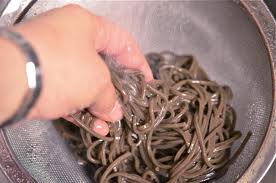Buckwheat- The Grain thats not a Grain!

Buckwheat is not actually a grain although most people think it is. Which makes sense since it is often categorized in the grain group and used as a grain. Surprisingly it is a fruit. Because it is not a grain, it can be enjoyed by populations sensitive to wheat and other grains, including those with celiac disease.
One method of eating buckwheat is in the form of noodles, similar to spaghetti. These noodles are sometimes called “soba noodles” and are popular in Asian dishes, although you can also use them to replace spaghetti in Italian dishes.
Nutrition Props: A 3.5 oz serving of buckwheat noodles contains 360 calories, which is close to being considered high. A high level of calories is 400 by FDA guidelines. However, buckwheat noodles are low in fat, with 4 percent daily value (DV) of fat and 0 g saturated fat. At 3 percent DV sodium, they are also a low-sodium food. Checkout this easy, delish recipe!
By FDA guidelines, 5 percent or less daily value percentage is considered low; 20 percent or more is high.
Nutrients: Buckwheat noodles contain high levels of healthy nutrients. Buckwheat noodles contain 22 percent DV carbohydrates, 4 percent fiber and 28 percent protein, so these noodles pack a lot of energy. Compared to wheat, buckwheat contains more of the amino acid lysine and vitamin E, although it has less fiber than wheat. Antioxidants G.E. Inglett found high levels of antioxidants, phenolic compounds and flavonoids in buckwheat flour.
According to this study, buckwheat beat oats and barley in phenolic compound amounts by two to five times and contains two to seven times more antioxidants than oats and barley.
Medicinal uses: Buckwheat contains a glycoside called rutin, a medicinal chemical that strengthens capillary walls. One clinical study showed mixed results in the treatment of chronic venous insufficiency.
Dried buckwheat leaves for tea were manufactured in Europe under the brand name “Fagorutin”. A buckwheat protein has been found to bind cholesterol tightly. It is being studied for reducing plasma cholesterol in people with hyperlipidemia.
A Fruit with Benefits: Buckwheat might be a viable option for people with celiac disease, who cannot consume grains such as wheat and rye, Donald D. Kasarda from the USDA explains. Buckwheat has significantly lower levels of gluten, which individuals with celiac disease are intolerant to, than wheat. Buckwheat also shows possibility for diabetics.
A 2009 Russian study, conducted by Kh. Kh. Sharafetdinov and colleagues, and reported by the Food and Agriculture Organization of the United Nations, studied different types of grains and how they affected diabetics. The researchers recommended products made with buckwheat flour for diabetics after the study showed foods with buckwheat caused one of the lowest sugar increases and had one of the lowest glycemic levels out of all foods in the study. Beer In recent years, buckwheat has been used as a substitute for other grains in gluten-free beer.
Sources and thanks to livestrong.com wikipedia.org/wiki/Buckwheat G.E. Inglett and colleagues Kh. Kh. Sharafetdinov –
